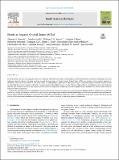Fjords as Aquatic Critical Zones (ACZs)
Abstract
In recent decades, the land-ocean aquatic continuum, commonly defined as the interface, or transition zone, between terrestrial ecosystems and the open ocean, has undergone dramatic changes. On-going work has stressed the importance of treating Aquatic Critical Zones (ACZs) as a sensitive system needing intensive investigation. Here, we discuss fjords as an ACZ in the context of sedimentological, geochemical, and climatic impacts. These diverse physical features of fjords are key in controlling the sources, transport, and burial of organic matter in the modern era and over the Holocene. High sediment accumulation rates in fjord sediments allow for high-resolution records of past climate and environmental change where multiple proxies can be applied to fjord sediments that focus on either marine or terrestrial-derived components. Humans through land-use change and climatic stressors are having an impact on the larger carbon stores in fjords. Sediment delivery whether from accelerating erosion (e.g. mining, deforestation, road building, agriculture) or from sequestration of fluvial sediment behind dams has been seriously altered in the Anthropocene. Climate change affecting rainfall and river discharge into fjords will impact the thickness and extent of the low-salinity layer in the upper reaches of the fjord, slowing the rate of the overturning circulation and deep-water renewal – thereby impacting bottom water oxygen concentrations.
Citation
Bianchi , T , Arndt , S , Austin , W , Benn , D I , Bertrand , S , Cui , X , Faust , J , Koziorowska-Makuch , K , Moy , C , Savage , C , Smeaton , C , Smith , R & Syvitski , J 2020 , ' Fjords as Aquatic Critical Zones (ACZs) ' , Earth Science Reviews , vol. 203 , 103145 . https://doi.org/10.1016/j.earscirev.2020.103145
Publication
Earth Science Reviews
Status
Peer reviewed
ISSN
0012-8252Type
Journal article
Description
The Jon and Beverly Thompson Endowed Chair in Geological Sciences at the University of Florida supported T. Bianchi's time and effort in writing this manuscript. Katarzyna Koziorowska-Makuch's participation in this study was supported by the Foundation for Polish Science (FNP). X. Cui would like to acknowledge Simons Foundation collaboration on the origins of life at Massachusetts Institute of Technology. W. Austin and C. Smeaton are funded by Marine Scotland through the Scottish Blue Carbon Forum.S. Arndt acknowledges funding from the European Union's Horizon 2020 research and innovation programme under the Marie Skłodowska-Curie grant agreement no.643052 (C-CASCADES project). J. Faust would like to acknowledge the ChAOS project (NE/P006493/1), part of the Changing Arctic Ocean programme and funded by the UKRI Natural Environment Research Council (NERC).Collections
Items in the St Andrews Research Repository are protected by copyright, with all rights reserved, unless otherwise indicated.

